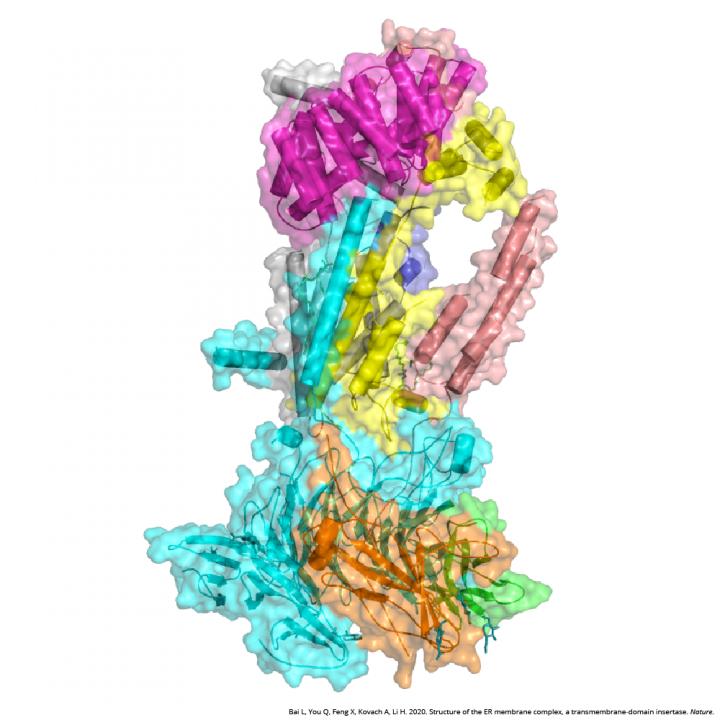
Credit: Courtesy of Dr. Huilin Li, Van Andel Institute
GRAND RAPIDS, Mich. (June 3, 2020) — Van Andel Institute scientists have revealed the first known atomic structure of a “molecular machine” responsible for installing critical signaling proteins into cellular membranes.
The findings, published today in Nature, shed new light on how this process works, and lay the foundation for potential future therapies for diseases like cancer, Alzheimer’s and cystic fibrosis.
“Determining precisely how proteins are assembled and function is central to understanding how the body works on the most basic level,” said VAI Professor Huilin Li, Ph.D., leader of the Institute’s Structural Biology Program and the study’s senior author. “Our findings provide a map for future studies that one day could be translated into ways to combat disease.”
Proteins are the molecular workhorses of the body, responsible for carrying out nearly every biological function. Roughly one-third of proteins are membrane proteins, whose jobs include relaying information to and from cells, and transporting ions and molecules through the cell membrane, among other vital tasks. These important roles make them popular marks for therapy — more than half of the medications on the market target membrane proteins as a way to treat disease.
The endoplasmic reticulum membrane complex, or EMC, is embedded in the endoplasmic reticulum, a system of membranes within cells that plays a part in the creation, editing and transport of proteins. When the EMC’s machinery breaks down, protein production can go awry, resulting in misshapen proteins that cannot do their jobs properly. For example, problems with the EMC are directly associated with cystic fibrosis, a genetic lung disease caused by improper assembly of a protein called CFTRDF508.
Using the Institute’s powerful cryo-electron microscopes (cryo-EM), Li and his colleagues visualized the EMC of a common yeast strain. Yeast are commonly used models in biology because they have many of the same molecular systems as humans but are much simpler to study.
They found that the yeast EMC is larger than previously thought, containing eight protein subunits instead of six. Additionally, the core of the EMC resembles a protein that performs a similar function as the EMC in bacteria, suggesting that the EMC in eukaryotic organisms like mammals may have arisen from bacterial systems.
Collectively, the findings shed light on how membrane proteins become established in membranes and how they change from their unstructured form to their functional form once there — processes that have not been well understood until now.
###
Today’s study was made possible by VAI’s state-of-the-art David Van Andel Advanced Cryo-Electron Microscopy Suite, which allows scientists to view some of life’s smallest components in exquisite detail. VAI’s most powerful microscope, the Titan Krios, can visualize molecules 1/10,000th the width of a human hair.
Authors include Lin Bai, Ph.D., Qinglong You, Ph.D., Xiang Feng, Ph.D., and Amanda Kovach of VAI.
Research reported in this publication was supported by Van Andel Institute and the National Cancer Institute of the National Institutes of Health under award no. CA231466 (Li). The content is solely the responsibility of the authors and does not necessarily represent the official views of the National Institutes of Health.
ABOUT VAN ANDEL INSTITUTE
Van Andel Institute (VAI) is committed to improving the health and enhancing the lives of current and future generations through cutting edge biomedical research and innovative educational offerings. Established in Grand Rapids, Michigan, in 1996 by the Van Andel family, VAI is now home to more than 400 scientists, educators and support staff, who work with a growing number of national and international collaborators to foster discovery. The Institute’s scientists study the origins of cancer, Parkinson’s and other diseases and translate their findings into breakthrough prevention and treatment strategies. Our educators develop inquiry-based approaches for K-12 education to help students and teachers prepare the next generation of problem-solvers, while our Graduate School offers a rigorous, research-intensive Ph.D. program in molecular and cellular biology. Learn more at vai.org.
Media Contact
Beth Hinshaw Hall
[email protected]
Related Journal Article
http://dx.




